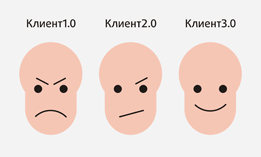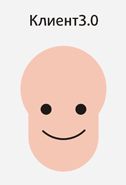A good customer is the one who twice changed the web developer
 Many of us are very worried when customers leave us to competitors, and are very happy when customers run back in the opposite direction. Those who are wiser look at this question more philosophically: let the bad customers leave, but the good ones come.
Many of us are very worried when customers leave us to competitors, and are very happy when customers run back in the opposite direction. Those who are wiser look at this question more philosophically: let the bad customers leave, but the good ones come. I propose to pay attention to the following paradox: sometimes a client with competitors behaved simply in a boorish manner, and by moving to a new developer he managed to build excellent relationships. And the question here is not so much that someone has higher communication abilities, not at all. It’s just that the client is growing professionally. And I was born the theory of two changes of the developer. The code name for the theory is “Client3.0”
Client1.0
 Narcissistic dreamer. He judges the web only as a consumer. Believes that all sites are too standard. I am sure that he will definitely do something original, out of the ordinary, capable of shaking the entire Internet.
Narcissistic dreamer. He judges the web only as a consumer. Believes that all sites are too standard. I am sure that he will definitely do something original, out of the ordinary, capable of shaking the entire Internet. The creation of a site refers to how to buy a car or buy a painting: he wants him to be immediately given a completely ready-made working fine mechanism, beautiful and unique.
Attitude to the first developer:
- You do everything to me, and if I don’t like something, I won’t pay you anything.
The work ends on a clumsy site. The developer considers the customer stupid, the customer considers the developer not executive. Actually diverge by enemies.
Client2.0
 While the site was being developed, the customer watched only that everything would be done as he intended. Any objections and suggestions of the developer were completely ignored. The customer waited for him to do everything, and then everything will work by itself. But it didn’t work by itself, and the customer starts a new job with a new developer in a new way.
While the site was being developed, the customer watched only that everything would be done as he intended. Any objections and suggestions of the developer were completely ignored. The customer waited for him to do everything, and then everything will work by itself. But it didn’t work by itself, and the customer starts a new job with a new developer in a new way. The attitude to the site as to tuning the car, but with the proposals of the developer. Previously, the Customer believed that only he could be creative, now he wants the developer to be also with ideas.
The customer evaluates his ideas more critically. Developer requirements are more meaningful and specific. Client 2.0 learns to respect the work of the developer, but so far there is no understanding that he himself needs to make a lot of effort.
Attitude towards the developer:
- If I knew how to make sites, I would have done everything long ago. But you have to deal with you.
The work ends externally correctly, but with hidden discontent. Reason: there is no return from the site.
Client3.0
 If the customer needs a website that should really bring customers, then he matures to a new developer. The goals are quite specific, and the implementation methods are completely trusted by the developer.
If the customer needs a website that should really bring customers, then he matures to a new developer. The goals are quite specific, and the implementation methods are completely trusted by the developer. Any idea is first discussed with the developer. The word "Creative" is forgotten as a nightmare. There is a goal: bring a client. Everything works for this purpose.
The attitude to the site as a stream of information that needs to be conveyed to site visitors.
Attitude towards the developer:
- Everyone should do his own thing. You understand the sites, we trust you.
The client is not an object, he is a living being, and he is developing
I developed this theory of customer evolution, or customer’s circuit in a competitive environment of web developers, based on my not very rich experience. But three of my most stable and reliable customers came to me after they refused to cooperate with two competitors. The trend, however.
Now, when customers who are faced with site building for the first time come to me, I am not very willing to get to work. Because I see how raw and naive their ideas about future work are. And I’m very afraid that the relationship will be ruined, but not because of my gouging, but because the client is still 1.0.
But I’m very willing to take on a customer who has already felt the web. With him you can build relationships.
What to do?
1. Relate to everything philosophically. A client left you: his fate is like that.
2. Customer education: our common goal. We all, website builders and IT developers in general, must make efforts to ensure that the future client is more advanced. That the client would come to us immediately in the state of Client 3.0.
How to build communication with Client 1.0?
With the submission of piumosso, I propose the following algorithm for communicating with client 1.0:
1. First, try to turn it into client 3.0. Develop his myths, convince him of the meaninglessness of bad ideas, praise him for good ideas, convince him to listen to you.
2. If you can’t convince, then tell the client directly that you think his venture is bad. Agree to work only with clearly defined TOR. And do not forget to request separate money for writing this TK.
3. If neither the first nor the second succeeds, politely recommend to the customer the most evil competitor.
In fact, I consider customers to be people from another test?
Most customers consider us IT people to be people of this world, born with supernormal abilities, unable to understand a normal person.
So, “Normal People”, I’ll tell you a terrible secret: yes, we consider you funny little animals and classify you according to every opportunity!
Authorship
The author of the article and the picture: Vadim Galkin. When republishing this article, please link to my personal page .
